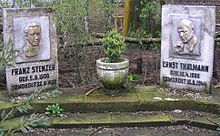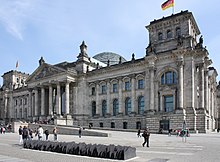Franz Stenzer
Franz Stenzer (born June 9, 1900 in Planegg , † August 22, 1933 in Dachau ) was a German communist, member of the Reichstag and a victim of the Nazi regime .
Life
After attending primary school in his Bavarian birthplace, Franz Stenzer became a railroad worker. During the First World War he did his military service as a seaman in the Imperial Navy, where he rebelled against the military drill and received strict arrest for one month. After the war he worked in the depot I in Munich, where he joined the KPD in 1920 . The workforce elected him to the works council, and in 1922 he became its second chairman. In 1924 Stenzer became a member of the KPD district party leadership in southern Bavaria, where he mainly worked in the trade union department. In 1928/29 he also took on the role of head of agitation and propaganda in the revolutionary trade union opposition in Bavaria. Because of this function he was delegated in 1929 to a course at the International Lenin School of the Communist International in Moscow. Then Stenzer took over functions on behalf of the Central Committee of the KPD, such as responsibility for regional trade union work as a "Central Committee instructor". At the same time he was councilor of his party in the Munich city council and from the end of 1930 editor-in-chief of the Neue Zeitung in Munich. In 1932 he acquired further knowledge for his political activities in the Red Trade Union International in Moscow. Through the Reichstag election in November 1932 , he came from constituency 26 (Franconia) as a member of the KPD parliamentary group in the Reichstag .
After the takeover of the Nazis Stenzer dipped initially, but took example in the illegal meeting of the Central Committee of the Communist Party on February 7, 1933 Sporthaus Ziegenhals part to subsequently organize the illegal work from the underground in southern Germany. The Gestapo found his hiding place in Munich; she arrested him on May 30, 1933. After months of interrogation and abuse, Franz Stenzer was murdered on August 22, 1933 in the Dachau concentration camp . According to Himmler in a letter to the Bavarian Minister of the Interior, Adolf Wagner , Stenzer was killed by an SS soldier when he allegedly tried to escape when he was shot in the neck (see also: " Post obligation " in concentration camps ). Investigations against the Scharführer were set in December 1933 because his account could not be refuted. A forensic medical report had not previously produced a clear result. After the end of the war, the case was again entrusted to American investigators, and there were no further trials.
Stenzer was married; the marriage produced three daughters. Stenzer's wife has been held hostage since April 1933 and released one day after her husband's funeral. In November 1933 she fled first to the Saar region , then to Paris and in August 1934 to the Soviet Union. During the Stalinist persecution in 1937 she was expelled from the KPD and was imprisoned until 1938. She returned to Germany in 1946, later lived in the GDR and died in Berlin in March 1998. Stenzer's daughter Emmi was married to Markus Wolf from 1944 and, as a literary scholar, was the administrator of the estate of her father-in-law Friedrich Wolf .
For the SED leadership, Franz Stenzer's way of life was a role model as a brave and steadfast fighter against fascism and militarism. His biography was written down through questioning family members, fellow prisoners and former comrades in arms. New Germany published a three-part report in September 1963 under the title “A Life for the Working Class”. In the 1970s, a research group on the Dachau concentration camp published Franz Stenzer's last letter of June 24, 1933 in a collection of materials on the camp victims. In the GDR, a "Franz Stenzer song" was also commissioned.
Commemoration
- In Berlin, one of the largest Reichsbahn repair works of the Deutsche Reichsbahn bore his name from 1967 until it was closed in 1995.
- On the grounds of the RAW there is a memorial stone with a portrait relief of Stenzer and this inscription: “Franz Stenzer, geb. June 9, 1900, murdered August 22, 1933. "
- In Berlin-Friedrichshain there was also a school at Niemannstrasse 3 named after Franz Stenzer. There was a corresponding portrait relief on the building.
- Since 1992, one of the 96 memorial plaques for members of the Reichstag murdered by the Nazis has been commemorating Stenzer near the Reichstag .
- He is the namesake of Franz-Stenzer-Strasse in Pasing and Berlin.
- A cargo ship of the GDR merchant navy also bore his name.
- In 1984 a memorial stone for Franz Stenzer was erected in Eisenach , Willi-Enders- Strasse, and the combat group battalion of the VEB Automobilwerk Eisenach (AWE) bore his name.
literature
- History workshop Working and living in Pasing e. V. (Ed.): Traces, contributions to Pasinger history, profile, Munich 1989, ISBN 3-89019-235-1 .
- Klaus Drobisch and Günther Wieland: System of the Nazi concentration camps 1933–1939 , 1993, ISBN 3-05-000823-7 .
- Bavaria in the Nazi era , ISBN 3-486-42401-7 .
- Hermann Weber , Andreas Herbst : German communists . Biographisches Handbuch 1918 to 1945. 2nd, revised and greatly expanded edition. Dietz, Berlin 2008, ISBN 978-3-320-02130-6 ( online [accessed January 5, 2013]).
- Siegfried Mielke , Stefan Heinz : Railway trade unionists in the Nazi state: persecution - resistance - emigration (1933–1945) . Metropol Verlag, Berlin 2017, ISBN 978-3-86331-353-1 , pp. 684 .
Web links
- Franz Stenzer in the database of members of the Reichstag
- Short biography
Individual evidence
- ^ A b c d Hans Maur : Memorials of the workers' movement in Berlin-Friedrichshain , ed. by the district management of the SED, district commission for researching the history of the local labor movement in cooperation with the district commission for researching the history of the local labor movement at the district management Berlin-Friedrichshain of the SED, 1981, p. 122f.
- ↑ Martin Schumacher (Ed.): MdR The Reichstag members of the Weimar Republic in the time of National Socialism. Political persecution, emigration and expatriation 1933–1945. Droste-Verlag, Düsseldorf 1991, ISBN 3-7700-5162-9 , p. 567.
- ^ Weber, German Communists .
- ↑ Text and material collection for the memorial event for Franz Stenzer in Berlin, cultural hall of the Reichsbahn repair shop on August 22, 1983.
| personal data | |
|---|---|
| SURNAME | Stenzer, Franz |
| BRIEF DESCRIPTION | German politician (KPD), MdR and resistance fighter |
| DATE OF BIRTH | June 9, 1900 |
| PLACE OF BIRTH | Planegg |
| DATE OF DEATH | August 22, 1933 |
| Place of death | Dachau |



